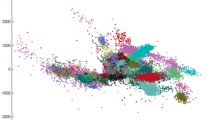Abstract
One of the most significant indicator of heart disease is arrhythmia showing heartbeat patterns. Thus, early and accurate detection of arrythmia types by categorization of heartbeats is important. In this paper, we introduce an ECG beat classifier system integrating two main parts: feature extraction and classification. For the first part, we consider the features observed in the time–frequency (t, f) plane where the ECG is projected using a variant of Stockwell transform. For the second part, the framework of semi-supervised SVM with asymmetric costs (AS3VM) has been applied for assessment of the obtained feature sets performance. Notice that four heartbeat types have been considered: normal beats (N), left and right bundle branch blocks (L and R) and premature ventricular contractions (V). The proposed method has been evaluated on PhysionNet’s MIT-BIT arrythmia database. The obtained results show that the suggested approach achieves significant separability of the classes and thus, able to make prediction accuracies of \(99.35\%\), \(98.73\%\), \(98.57\%\) and \(99.44\%\) for, respectively, N, L, R and V beats.




Similar content being viewed by others
References
De-Chazal, P., Reilly, R.: Automatic classification of ECG beats using waveform and heartbeat interval features. In: IEEE Xplore, ICASSP 2003, pp. 269–272 (2003)
Christov, I., Gomez-Herrero, G., Krasteva, V., Jecova, I., Gotchev, A.: Comparative study of morphological and time–frequency ECG descriptors for heartbeat classification. Med. Eng. Phys. 28, 876–887 (2006)
Krasteva, V., Jecova, I.: QRS template matching for recognition of ventricular ectopic beats. Ann. Biomed. Eng. 55(12), 2065–2076 (2007)
Ye, C., Kumar, B.V.K.V., Coimbra, M.T.: Heartbeat classification using morphological and dynamic features of ECG signals. IEEE Trans. Biomed. Eng. 59(10), 2930–2941 (2012)
Chen, S., Hua, W., Li, Z., Li, J., Gao, X.: Heartbeat classification using projected and dynamic features of ECG signal. Biomed. Signal Process. Control 31, 165–173 (2017)
Khazaee, A., Ebrahimzadeh, A.: Classification of electrocardiogram signals with support vector machines and genetic algorithms using power spectral features. Biomed. Signal Process. Control 5, 252–263 (2010)
Talbi, M.L., Charef, A.: PVC discrimination using the QRS power spectrum and self-organizing maps. Comput. Methods Programs Biomed. 94, 223–231 (2009)
Zidelmal, Z., Amirou, A., Ould-Abdeslam, D., Merckle, J.: ECG beat classification using a cost sensitive classifier. Comput. Methods Programs Biomed. 111(3), 570–577 (2013)
Manab, K., Samit, A.: ECG beat classification using mixture of features. International Scholarly Research Notices (2014)
Raj, S., Ray, K.C., Shankar, O.: Cardiac arrhythmia beat classification using DOST and PSO tuned SVM. Comput. Methods Programs Biomed. 136, 163–177 (2016)
Oh, S.L., Ng, E.Y., Tan, R.S., Acharya, U.R.: Automated beat-wise arrhythmia diagnosis using modified U-net on extended electrocardiographic recordings with heterogeneous arrhythmia types. Comput. Biol. Med. (2018). https://doi.org/10.1016/j.compbiomed.2018.12.012
Ramirez, E., Melin, P., Prado-Arechiga, G.: Hybrid model based on neural networks, type-1 and type-2 fuzzy systems for 2-lead cardiac arrhythmia classification. Expert Syst. Appl. (2019). https://doi.org/10.1016/j.eswa.2019.02.035
Stockwell, R.G., Mansinha, L., Lowe, R.P.: Localisation of the complex spectrum: the S-Transform. IEEE Trans. Signal. Process 44(4), 998–1001 (1996)
Zidelmal, Z., Hamil, H., Moukadem, A., Amirou, A., Ould-Abdeslam, D.: S-transform based on Compact Support Kernel. Digit. Signal Proc. 62, 137–149 (2017)
Mark, R., Moody, G.: MIT-BIH arrhythmia database. http://www.physionet.org/physiobank/database/mitdb/. Accessed 16 Sept 2018
Mark, R., Wallen, R.: AAMI-recommended practice: testing and reporting performance results of ventricular arrhythmia detection algorithms. Technical Report, ECAR, AAMI (1987)
Köhler, B.U., Hennig, C., Orglmeister, R.: The principles of software QRS detection. IEEE Eng. Med. Biol. Mag. 21(3), 42–57 (2002)
Zidelmal, Z., Amirou, A., Adnane, M., Belouchrani, A.: QRS detection using wavelet coefficients. Comput. Methods Programs Biomed. 107(3), 490–496 (2012)
Zidelmal, Z., Amirou, A., Ould-Abdeslam, D., Moukadem, A., Dieterlin, A.: QRS detection using S-Transform and Shannon Energy. Comput. Methods Programs Biomed. 116(1), 1–9 (2014)
Zidelmal, Z., Amirou, A., Belouchrani, A.: Heartbeat classification using Support Vector Machines (SVMs) with an embedded reject option. Int. J. Pattern Recogn. Artif. Intell. 26(01), 1250001 (2012)
Lfhede, J., Thordstein, M., Lfgren, N., Flisberg, A., Rosa-Zurera, M., Kjellmer, I., Lindecrantz, K.: Automatic classification of background EEG activity in healthy and sick neonates. J. Neural Eng. 7(1), 016007 (2010)
Boashash, B., Azemi, G., Khan, N.A.: Principles of time–frequency feature extraction for change detection in non-stationary signals: applications to newborn EEG abnormality detection. Pattern Recognit. 48, 616–627 (2015)
Boashash, B.: Time–Frequency Signal Analysis and Processing: A Comprehensive Reference. Elsevier, Amsterdam (2015)
Sejdic, E., Djurovic, I., Jiang, J.: Time–frequency feature representation using energy concentration: an overview of recent advances. Digit. Signal Proc. 19(1), 153–183 (2009)
Vapnik,V.N: The nature of Statistical Learning Theory. 2nd Ed. New York (2000)
Joachims, T.: Transductive inference for text classification using support vector machines. In: Proceedings of ICML-99, pp. 200–209. Morgan Kaufmann Publishers, San Francisco (1999)
Acknowledgements
This work was partly supported by the Algerian Ministry of Higher Education and research under the CNEPRU Project: A10N01UN150120150001.
Author information
Authors and Affiliations
Corresponding author
Additional information
Publisher's Note
Springer Nature remains neutral with regard to jurisdictional claims in published maps and institutional affiliations.
Rights and permissions
About this article
Cite this article
Lekhal, R., Zidelmal, Z. & Ould-Abdesslam, D. Optimized time–frequency features and semi-supervised SVM to heartbeat classification. SIViP 14, 1471–1478 (2020). https://doi.org/10.1007/s11760-020-01681-9
Received:
Revised:
Accepted:
Published:
Issue Date:
DOI: https://doi.org/10.1007/s11760-020-01681-9




